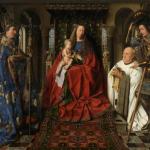This archived website 'Flemish primitives' is temporarily not being updated. Certain functionality (e.g. specific searches in the collection) may no longer be available. News updates about the Flemish primitives will appear on vlaamsekunstcollectie.be. Questions about this website? Please contact us at info@vlaamsekunstcollectie.be.
Madonna with Canon Joris Van der Paele



Jan van Eyck is one of the most famous 'Flemish Primitives' and is credited with originating the painting style associated with them. As a court painter-he first entered the service John of Bavaria, the Count of Holland, in The Hague and afterwards served at the court of the Duke of Burgundy, Philip the Good-he is to be considered one of the most important painters of his era. He gained a reputation particularly because of his distinctive painting style, which is characterised by a great feeling for detail, a minutely accurate execution method and a vivid colour palette.
Van Eyck was probably born around the year 1395 in Maaseik. His name first appears in documents in 1422. At the time he was working in The Hague as a master painter for the Count of Holland. The documents imply that he had been working on a number of miniatures during this period. Very often miniatures in the Très belles heures de notre Dame de Jean de Berry, or in short, the Turin-Milan manuscript (Museo Civico d'Arte Antica, Turin) are also attributed to Van Eyck. Following the death of the Count in 1425, Van Eyck moved to Bruges, where shortly afterwards he was appointed as court painter and 'varlet de chambre' (personal attendant) by Philip the Good. At the end of the 1420's Van Eyck was sent on several diplomatic missions on behalf of the Duke.
A couple of important works of his relatively small oeuvre that have been handed down are housed by the Groeninge Museum in Bruges and the KMSK (Royal Museum of Fine Arts) in Antwerp. The Madonna with Canon Van der Paele (Groeninge Museum) is one of the best-known works from his oeuvre. This painting which, apart from the Adoration of the Mystic Lamb (Saint Bavo Cathedral, Ghent), is also Van Eyck's largest painting and which is the focus here. Van Eyck produced this painting between 1434 and 1436.
The painting
Jan van Eyck, Madonna with Canon Joris Van der Paele, Groeninge Museum, Bruges.
The painting Madonna with Canon Joris Van der Paele shows the Virgin Mary with her Child amidst Saint Donatian of Reims, Saint George and the commissioner of the painting, Canon Van der Paele. The Canon is portrayed dressed in a white surplice, kneeling down in front of Mary and Baby Jesus, holding his prayer book and his glasses in his hands. Mary is seated on a copiously decorated throne dressed in a red cloak. Jesus is sitting on her lap on a white cloth. He is playing with a green, ring-necked parakeet while handing a little bouquet of flowers to Mary. Next to Joris Van der Paele, his patron saint, Saint George, is walking into the scene, dressed in a harness. He takes off his helmet and salutes Jesus with 'Adona[i]' ('lord' in Hebrew) - as written on his harness - and introduces the Canon to Mary and Jesus. He is holding a white flag with a red cross clasped in his arm.
On Mary's left is the bishop Saint Donatian of Reims. He is wearing a cope (a liturgical garment) decorated with golden and blue embroidery and a mitre. In one hand he is holding a crosier and in the other hand his attribute, a wheel with five burning candles. The scene is depicted in an apse or a rounded construction, of which the round arches are supported by pillars featuring ornamented capitals.
The painting is still mounted in its original frame. This frame has several inscriptions amongst which is the artist's signature.
The Assignment

The bottom side of the frame shows the following inscription: HOC OP ' FECIT MAGR GEORGI' DE PALA HUI' CANONI P IOHANNE DE EYCK PICTORE . ET FUNDAVIT HIC DUAS CAPELLIAS DE I GMO CHORI DOMINI . M . CCCC . XXXIIIJ . PL AU . 1436. This means: 'Master Joris van der Paele, Canon of this church, commissioned the painter Johannes van Eyck to produce this work and he founded two 'kapelaniën' as part of the choir, 1434. He completed it, however, in 1436'.
From this inscription it appears that Canon Joris Van der Paele ordered this memorial table from Jan van Eyck and that the work was completed in 1436. The inscription also tells us that Van der Paele issued the assignment because he had set up two 'kapelanieën' (a 'kapelanie' is a foundation consisting of goods or money by which the donor establishes so that Masses will be read for the salvation of his or her soul) at the St. Donaas Church. Investigation of archives, however, has proven that Van der Paele did not set up these two 'kapelanieën' at the same time. He established the first one in 1434, a few days after he had been discharged from all his obligations as a canon due to his deteriorating health. With this 'kapelanie', Van der Paele - who was ill at the time - established that three Masses a week, amongst which a Requiem Mass and a Holy Cross Mass, would be read for the salvation of his soul. After his death, these Masses would be required to be ended with a Miserere mei and a Profundis, after which his grave would have to be sprinkled with holy water. Setting up this 'kapelanie' was the reason Van der Paele ordered the painting from Van Eyck.
In 1440 the Canon set up a second 'kapelanie'. This time, he established that every year on the day of his death a Mass was to be read for all of the canons and curates of the St. Donaas Church, amongst whom was also his deceased brother. Most likely the inscription on the frame was changed following this second foundation into DUAS CAPELLIAS, which means 'two kapelanies'.

Iconography
Canon Joris Van der Paele had a clear objective in mind with this altarpiece. The painting, which was meant to keep the memory of the canon alive, contains a complex iconography, consisting of different layers. First of all, the Virgin Mary is worshipped in this memorial table.
The representation of Mary amidst a number of saints is sometimes called the sacra conversazione, literally meaning 'holy conversation'. Although this Italian term seems to indicate that we are dealing with an Italian picture theme, this painting by Van Eyck is actually the earliest known example. Previously, it used to be common practice not to portray the saints on the same panel as the Virgin, but to depict them on separate panels or on the shutters against a golden background. Jan van Eyck has broken this iconography tradition for the first time in this painting.
Van der Paele is kneeling down in front of Mary. The prayer book in his hand suggests that he had been at his prayer until recently. The text in the book cannot be deciphered, but it could possibly be a text about or a prayer to Mary. This suspicion is reinforced by a quote on the frame, originating from the book of Wisdom (7: 29 and 26), which praises Mary as Queen of the heaven. The Latin text reads as follows: HEC E SPECIOSIOR SOLE + SVP OEM STELLARV DISPOSICOEM LVCI PATA IVEITVR POR . CADOR E ENI LVCIS ETERNE . + SPECLM SN MACLA DI MAIESTIS. This means: 'This one is more radiant than the sun and surpasses any arrangement of the stars. Compared to the light she is deemed to be purer, as she is the echo of the eternal light, the immaculate reflection of God's majesty'. Precisely the same text is also found in the lauds, which were read during the Assumption of Mary from the 'Brevarium' manuscript of the St. Donaas Church. By using this quote from the book of Wisdom, a deliberate reference is made in the painting to the important rôle that Mary has as mediator in heaven. Hence she is portrayed here in the hope that she will advocate a place in heaven for Canon Van der Paele. The line from the book of Wisdom is also literally depicted in the painting, because Mary's image is reflected in the harness of George.
Saint Donatian
The saints Donatian of Reims and George are also portrayed in this painting as mediators. Both saints take up a special place in the life of Joris Van der Paele. As Canon of the St. Donaas Church, Saint Donatian was an important patron saint for Joris Van der Paele. The St. Donaas Church in Bruges possessed a number of important relics of the saint and therefore the church was dedicated to him. In one hand the saint is holding a wheel with five burning candles. This refers to a miracle that took place in Donatian's youth where he is saved from death by drowning by a wheel with five burning candles. An inscription on the frame also refers to the same attribute. The translation of the inscription reads as follows: 'From one childbirth he was born as the ninth of his brothers, thrown into the water he was given back alive: reborn he became the first Archbishop of Reims. He now enjoys God's glory.'
Furthermore, the relationship between Saint Donatian and the Bruges St. Donaas Church is emphasized in the garments the saint is wearing. His cope and mitre are in fact identical to the descriptions of a cope and a mitre in old church inventories. Van Eyck has used the garments as a model. It must have had a special meaning to Van der Paele to see the saint portrayed here in garments that he used to wear himself as a canon.
Similarly the crosier Donatian is holding in his hand has been shaped after a crosier that was stored at the St. Donaas Church. The crosier contains a splinter of the original Cross and is an important link in the iconography of the memorial table.
Saint George
Saint George - being his namesake saint- was also an important patron saint for Joris Van der Paele. This is, however, not the only reason why the saint has been depicted here. As it happens, the St. Donaas Church possessed a bone from the saint's arm. This relic was one of the most important treasures belonging to the church.
An inscription referring to him can be found on the frame to his right. The Latin inscription says: 'Born in Cappadocia, he fought for Christ, fleeing from the worldly pleasures of life; he conquered through death and defeated the dragon'. George was a Greek soldier who died for his religion in the early Christian times. Later on he is identified with the saint in the story of George and the dragon. For these reasons George - as is the case in this painting - is often depicted in full armour, bearing a flag with a red cross.
Next to these meanings, the special colour scheme in the garments of both saints and Mary is quite striking. The colours - Saint Donatian in blue, Mary in red and Joris Van der Paele and his patron saint in white and gold - are identical to the heraldic colours of the city of Bruges.
Sacrificial Death and Resurrection
Although Mary and her son are the centre of this representation, Canon Van der Paele also takes up a key position. What is striking is that the canon has not fixed his attention on Mary but on the crosier Saint Donatian is holding in his hand. This relic holder from the St. Donaas Church, in which a splinter from the cross that Jesus died on was stored, refers figuratively by its form of a cross, as well as by the physical presence of the splinter from the cross, to the sacrificial death of Jesus at the cross. The same meaning is also found in the sculpture of on the left armrest of the throne. Traditionally, this murder is compared with Jesus' sentencing to death by the Jews.
In Christian iconography the sacrificial death of Jesus is inextricably linked to the fall of Adam and Eve. Because Adam and Eve ate from the tree with the forbidden fruits in the Garden of Eden, humankind lost the chance of eternal life. The Original Sin, which thus originated from this deed by Adam and Eve, was redeemed by the sacrificial death of Jesus. In the painting, the presence of Adam and Eve on the throne refers to this biblical event.
Defeat of Death
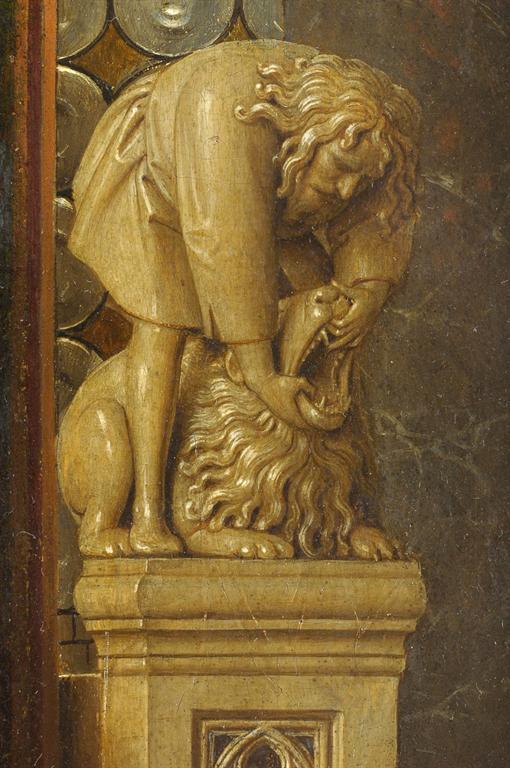
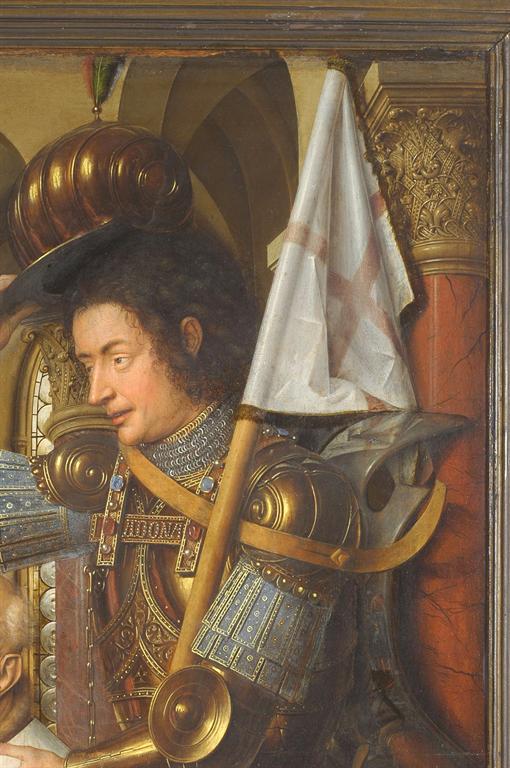
The theme of the defeat of death is also present in this painting. The sculpture of Samson and the lion on the right armrest emphasizes the role of Jesus as the Saviour. The image of Samson devouring the lion is traditionally seen as a prefiguration of Jesus who descends into limbo patrum and gets the good souls from pre-Christian times out of there and takes them to heaven. These good souls could not know the teachings of Jesus, simply because they had lived too early in time. This episode, which has not been written down in the Bible, but has, however, been largely spread as dating from the 4th century, is the symbol of the defeat of death, which has been made possible by the sacrificial death of Jesus. The same theme can also be found on the capital on the right in the background in which three conceptions, i.e. Abraham's Blessing of the Oriental kings, The Liberation of Loth and David and Goliath are depicted. These representations are also prefigurations of Jesus' descent into hell to free the good souls. Moreover the defeat of death is also reflected in the flag George is holding in his hand. In addition to the fact that the flag is George's attribute, it is also the attribute Jesus is depicted with during the resurrection.
The essence of the painting's iconography is assembled in the image of Mary and Jesus on the throne, with on their left Adam and Cain's Murder of Abel and on their right Eve and Samson and the Lion. Together they represent the entire salvation history: from the fall and the sacrificial death to the resurrection of the dead and eternal life. According to certain authors, this meaning is also reflected in the architecture.
Jan van Eyck, Madonna with Canon Joris Van der Paele, Groeninge Museum, Bruges.
Meaning of the Architecture
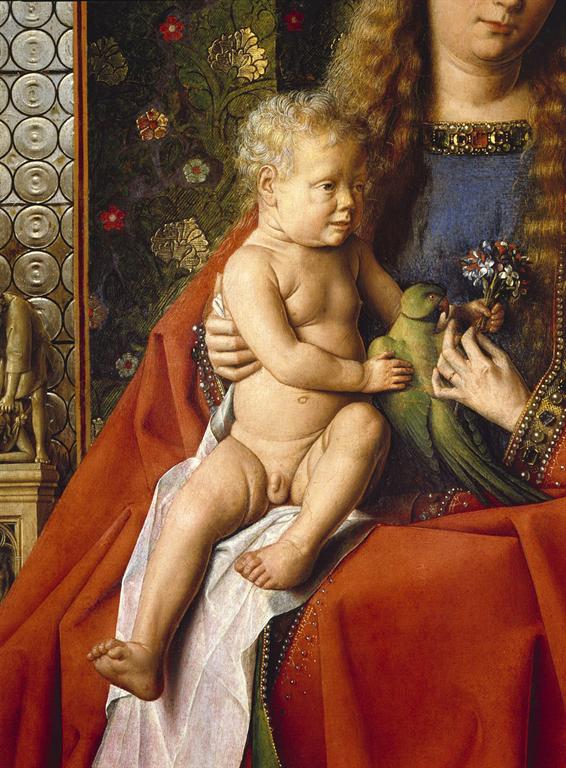
There has been much speculation in literature on the semicircular or circular room in which Mary, the saints and Canon Van der Paele have been portrayed. Did Van Eyck paint an image of an existing room? Or, did he invent the room? According to some authors, the architecture in which the depiction has been placed represents the holy burial chapel in Jerusalem. Others, howeve, believe that the apse of the St. Donaas Church served as an example. This latter theory cannot be checked anymore since the church was demolished during the French Revolution.
If Jan van Eyck did refer to the holy burial chapel in Jerusalem with the architecture, this would imply that the meaning of the sacrificial death and the defeat of death are emphasized even more. Tradition has it that the holy burial chapel is situated on the spot where Jesus was buried and resurrected from his grave. The basilica, of which the burial chapel is a part, also houses the place where Jesus was crucified. The symbolic meaning of this location, where the sacrificial death as well as the resurrection took place, encompasses the entire iconography of the painting. Unfortunately it cannot be established for certain whether this meaning was indeed Van Eyck's intent.
Despite the doubts about the location that has been depicted, it can be concluded for certain that Van Eyck painted a space in a church. The figures have been portrayed in the most important part of the church building, the space where one would usually find the altar. Mary, who has been depicted as too large in proportion to the building, occupies the symbolic place of the altar in the painting. This placement also changes the interpretation that should be given to the figure of Jesus. The sacrificial death and the resurrection are commemorated through the Eucharist in Christian liturgy. By placing Jesus on the white cloth on the symbolic altar, he is identified with the Eucharist. By including the Eucharist in the painting, the ritual with which the sacrificial death in the church is commemorated is also included. By doing this, Van Eyck makes an association with the daily church practice.
This meaning is also reflected in the capital on the left in the background on which several Biblical images can be discerned. On the left of the capital we find the representation of the Meeting of Abraham and Melchisedek and on its right the Sacrifice of Isaac. Both depictions are prefigurations of the Eucharist.
Iconography and Purpose
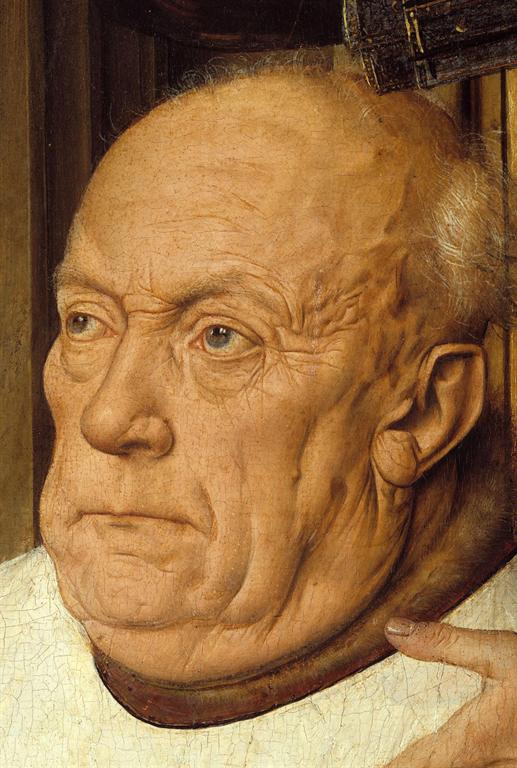
The complex iconography of this painting has everything to do with the salvation of Joris Van der Paele's soul. In addition to this the sacrificial death of Jesus and his resurrection are the recurring themes in this memorial table. Joris Van der Paele's strong fascination with the sacrificial death needs to be explained by the presence of the relic of the cross in the St. Donaas Church as well as his own imminent death. With this altarpiece, the 'kapelanieën' that were founded on his behalf and the mediation of the depicted saints, Joris Van der Paele hoped to secure a place in heaven.
Although the iconography of this painting has a clearly framed theme, the purpose of the work is not entirely clear. Joris Van der Paele founded the 'kapelanie' after which this painting was made in the south aisle at the altar of Peter and Paul. Just like his brother and uncle, Van der Paele was buried in the vicinity of this altar. Thus one possibility is that it was put up over his grave as an epitaph. However, it is just as likely that the painting has served as an altarpiece. Although no sound proof has been found for any of these hypotheses, it is, however, clear that the work was used as a memorial table.
History of the Painting
Shortly after it was finished, the painting already enjoyed great fame. As soon as the end of the Fifteenth Century, the first true and less-true copies of the painting appeared (e.g. in the Antwerp Royal Museum of Fine Arts). A very interesting work amongst the free copies based on the memorial table of Van Eyck, is a diptych made by Jan Gossaert. On the left panel is the image of Saint Donatian (Musée des Beaux-Arts, Tournai) and on the right panel is a portrait of Jean Carondelet, Joris Van der Paele's successor and commissioner of the painting (Nelson-Atkins museum of Art, Kansas City). Although these are not true copies, both paintings show unmistakable resemblances with Van Eyck's Madonna with Canon Van der Paele. Donatian for instance is wearing the same cope and mitre and he is holding the crosier and the wheel with the burning candles in his hand. Just like Joris Van der Paele, Carondelet is wearing a white surplice and he is holding a prayer book in his hand. The art-loving Jean Carondelet has probably ordered the diptych for his burial chapel in the Bruges St. Donaas Church and he has most likely intentionally chosen to include the reference to Van Eyck's masterpiece.
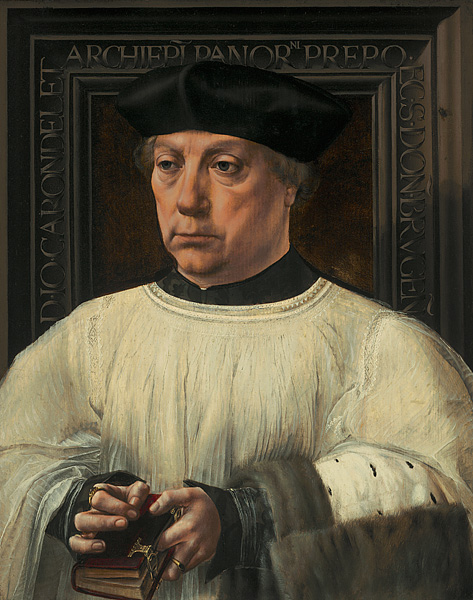
The aristocracy also shows an interest in the memorial table. In 1547, Mary of Hungary sends an envoy to the St. Donaas Church to request the painting. The members of the chapter are very strong-minded about their decision; they cannot hand over the work. The chapter's good care of the altarpiece is also proven by the fact that they hide the altarpiece somewhere during the religious perils, after which it is put back in the church in excellent condition.
On 21st August 1794, the painting is confiscated by the French and taken to Paris. The city of Bruges goes through a lot of trouble in 1815 to bring the work back to Bruges. And, it pays off in 1816 when the mission is accomplished. In the meantime, the St. Donaas Church has been demolished and the painting finds a residence in the newly founded academy.
The Secret of Jan van Eyck
Jan van Eyck's art has earned lots of admiration throughout the centuries. People have always been amazed at his accurate hand and the vivid colours in his paintings. These characteristics of his art were often attributed to the use of oil paint. Giorgio Vasari - an Italian artist and author of Le vite de' più eccelenti pittori, scultori e architettori (1550/1558) - even accredited the invention of oil paint to Jan van Eyck out of pure admiration for his work. According to Vasari, Jan van Eyck would have kept the composition totally secret and would have only with great exception divulged it to Rogier van der Weyden and the Italian artist Antonello da Messina, who had traveled to the Low Countries especially for this purpose.
This story is the beginning of the myth surrounding Jan van Eyck and oil painting, which has dominated all literature about the painter for a long time. In the meantime, it has been discovered that oil painting already existed in the 12th Century. Hence, Van Eyck can not have been the inventor of this technique. Yet compared to his predecessors Van Eyck's art shows such major differences, that it is extremely interesting to find out what exactly Van Eyck did do differently than his predecessors.
Until Van Eyck's era, painters would primarily use tempera paint. This paint is made of natural pigments, derived from plants and minerals, mixed with egg yolk and water. This paint has a soft colour and is opaque. Oil paint, on the contrary, consists of pigments mixed with (mostly) linseed oil. This gave the old, much-used pigments a radiant shine. Moreover the oil-based paint, contrary to the tempera paint, was transparent and hence could be penetrated by the light.
After oil paint had made its entry into the art environment, tempera paint was not immediately discarded. Artists would combine the two techniques. Van Eyck, however, only used oil paint. Moreover Van Eyck exploited the transparency of the paint. He used several thin layers of paint, which he would apply from light to dark, thus further intensifying the colour. This effect was emphasised yet again by the white layer of chalk, which was applied between the panel and the paint for insulation purposes. The reflection of the colours on the white undercoat is the key to the development of a deep shine of colours.
Yet this analysis of Van Eyck's working method does not explain the exceptional nature of Jan van Eyck's art works altogether. The paintings are minutely detailed and all have a special personality - this would never have been accomplished without the artist's outstanding craftsmanship. In his art works, Jan van Eyck knew how to combine the possibilities of a relatively new technique with exceptional talent, a feeling for detail and observation skills. It is the combination of all of these qualities that make Van Eyck's paintings so unique.
Bibliography
Marian W. Ainsworth, "Revelations about Jan van Eyck's ‘Virgin and child with saints Donatian and George, and the canon van der Paele'", in: Jérôme Bosch et son entourage et autre études, Le dessin sous-jacent et la technologie dans la peinture Colloque 14, Hélène Verougstraete [ed.], Leuven 2003, pp. 273-285.
Till-Holger Borchert, Jan van Eyck, 2007.
Pim Brinkman, Het geheim van Van Eyck, Zwolle 1993.
Dirk de Vos, Stedelijke Musea Brugge, Catalogus schilderijen 15de en 16de eeuw, Brugge 1979.
Aquilin Janssens de Bisthoven, M. Baes-Dondeyne en D. de Vos, De Vlaamse primitieven Corpus van de vijftiende- eeuwse schilderkunst in de Zuidelijke Nederlanden, Stedelijk Museum voor Schone Kunsten (Groeningemuseum) Brugge, Brussel 1981.
C. Harbison, Jan van Eyck, the play of realism, Londen 1990.
Margaret L. Koster, ‘De uitwisseling tussen Noord en Zuid anders bekeken: Florence en Vlaanderen', in: tent. cat. De eeuw van Van Eyck, de Vlaamse primitieven en het Zuiden 1430-1530, T. Borchert (ed.), 2002.
Carol J. Purtle, The Marian paintings of Jan van Eyck¸ Princeton 1982.
Ashok Roy, ‘Van Eyck's Technique: The Myth and the Reality, I', in: Investigating Jan van Eyck, Susan Foister, Sue Jones and Delphine Cool (eds.), pp. 97-100.
Christoph Schölzel, ‘Jan van Eycks Bindemittel - ein Geheimnis?', in: tent.cat. Das Geheimnis des Jan van Eyck, Thomas Ketelsen en Uta Neidhardt (eds.), München/Berlijn 2005, pp. 30-35.
Raymond White, ‘Van Eyck's Technique: The Myth and the Reality, II', in: Investigating Jan van Eyck, Susan Foister, Sue Jones and Delphine Cool (eds.), pp. 101-106.
Marian W. Ainsworth, "Revelations about Jan van Eyck's ‘Virgin and child with saints Donatian and George, and the canon van der Paele'", in: Jérôme Bosch et son entourage et autre études, Le dessin sous-jacent et la technologie dans la peinture Colloque 14, Hélène Verougstraete [ed.], Leuven 2003, pp. 273-285.
Till-Holger Borchert, Jan van Eyck, 2007.
Pim Brinkman, Het geheim van Van Eyck, Zwolle 1993.
Dirk de Vos, Stedelijke Musea Brugge, Catalogus schilderijen 15de en 16de eeuw, Brugge 1979.
Aquilin Janssens de Bisthoven, M. Baes-Dondeyne en D. de Vos, De Vlaamse primitieven Corpus van de vijftiende- eeuwse schilderkunst in de Zuidelijke Nederlanden, Stedelijk Museum voor Schone Kunsten (Groeningemuseum) Brugge, Brussel 1981.
C. Harbison, Jan van Eyck, the play of realism, Londen 1990.
Margaret L. Koster, ‘De uitwisseling tussen Noord en Zuid anders bekeken: Florence en Vlaanderen', in: tent. cat. De eeuw van Van Eyck, de Vlaamse primitieven en het Zuiden 1430-1530, T. Borchert (ed.), 2002.
Carol J. Purtle, The Marian paintings of Jan van Eyck¸ Princeton 1982.
Ashok Roy, ‘Van Eyck's Technique: The Myth and the Reality, I', in: Investigating Jan van Eyck, Susan Foister, Sue Jones and Delphine Cool (eds.), pp. 97-100.
Christoph Schölzel, ‘Jan van Eycks Bindemittel - ein Geheimnis?', in: tent.cat. Das Geheimnis des Jan van Eyck, Thomas Ketelsen en Uta Neidhardt (eds.), München/Berlijn 2005, pp. 30-35.
Raymond White, ‘Van Eyck's Technique: The Myth and the Reality, II', in: Investigating Jan van Eyck, Susan Foister, Sue Jones and Delphine Cool (eds.), pp. 101-106.

